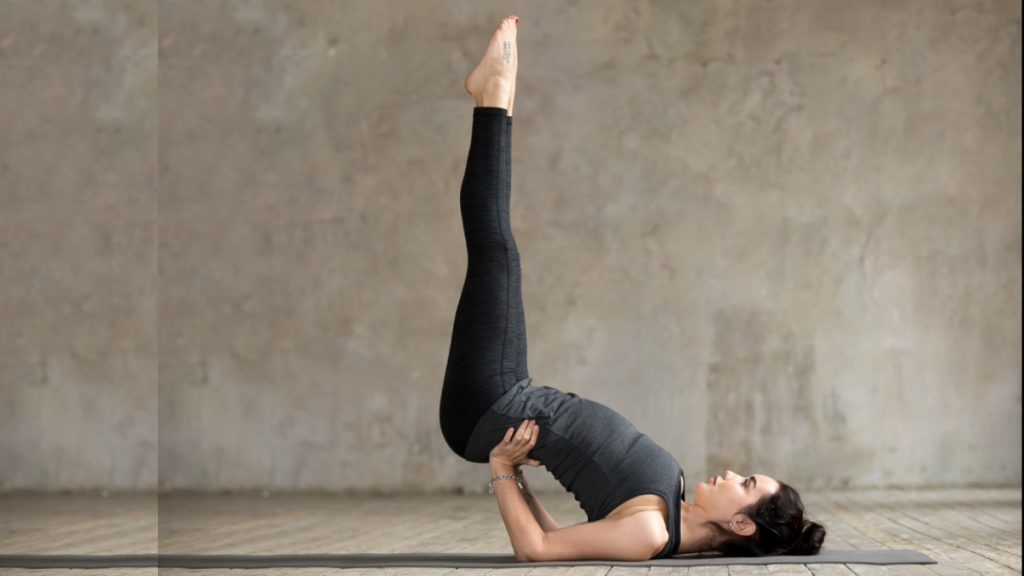Legs up the wall pose are also called Viparita Karani in Sanskrit. It is one of the healing yoga postures that provide many benefits, making it one of the best yoga poses for people who want some relaxation. It is easily accessible to people because of its ease and various options for modifications making it great for those people who are entirely new to exercise or yoga. It is often included in Hatha Yoga, therapeutic yoga classes, and Yin yoga. You can perform this pose on its own or as part of a cooldown. You can learn more about this Asanas from the best yoga school in Rishikesh, and get certified by completing the 200 hour yoga teacher training in Rishikesh.
How do Legs up the Wall Pose?
- You can place a cushion or a folded blanket, or a bolster under your hips. Making use of high support needs more reliability, like putting your hips very close to the wall. Adjust accordingly to search for a sweet spot.
- Now bend knees as per your convenience, and if it is giving you comfort, you can place one pillow between your wall and your knees. You can use a cushion or a folded blanket under the head and neck.
- To bring your attention inward through a practice called pratyahara, you can wish to cover your eyes by making use of a mask or a pillow.
- Now sit by keeping your right-hand side against the wall by bending your knees and drawing your feet towards your hips.
- Then swing your leg in an upward direction against the wall while turning to lie down flat on your back.
- Keep your hips against a wall or a little away, and keep your arms comfortably.
- Hold on to this position for about 20 minutes.
- To relax from this position, push yourself away from the wall.
- Now relax on your back for some moments.
- Bring your knees towards your chest and roll into your right side.
- Now rest for some moments before moving to an upright position.
If you are a complete beginner to yoga, then we strong recommend you to check this 100 hour yoga teacher training in Rishikesh and if you want to complete the course virtually then here are the best online yoga teacher training courses.
Advantages of Leg up the Wall Pose
It enhances blood circulation: Your leg starts swelling because of venous insufficiency, where your vein does not circulate blood from the legs to the heart. Weak circulation is because of blood pooling and retention in the legs that raise blood clotting and then swelling and discomfort. Even though you do not have venous insufficiency, sometimes standing or sitting for a long time can limit your body’s capability to circulate blood. Legs up the wall will help in this case.
It assists you in destressing: Yoga has a profound impact in destressing your body, and restorative yoga poses such as legs up the wall guide your body to a state of relaxation. Many patients describe that they find this pose very calming. Distressing leads to better physical and mental health along with a robust immune system.
It can have extra benefits: Along with the feeling of relaxation, legs up the wall assist you in giving you a better feel. Some people even claim that it helps in alleviating conditions like headaches, high blood pressure.
Now the question comes how often you should do Legs Up the Wall Yoga Pose?
It is often recommended to do this pose as a part of everyday restorative yoga practice. It should be done towards the end of your course. It is safe to do this pose once or twice a day, whether as part of yoga practices or standalone poses.
At first, your yoga instructor tells you to do it safely without causing strain to your spine or your neck. But slowly, it becomes straightforward to do.
When you have Certain Conditions, you should not try the Legs up the Wall Pose.
Like every yoga pose, there are certain risks associated with legs up the wall yoga posture. Avoid doing this pose when you have the following conditions:
Glaucoma: Invert poses increases intraocular pressure, which is the pressure of the fluid in your eyes. Therefore, this yoga posture is unsafe for those people who are suffering from glaucoma.
People with a specific condition that leads to the excess fluid volume in the body must avoid doing legs up the wall pose. It leads to stress in the heart. Some of the conditions include:
- High blood pressure
- Congestive heart failure
- Liver failure
- Kidney failure.
You might feel a tingling sensation in your legs and feet when you hold on to this pose for a long time. You might also feel as if your legs and your feet have fallen asleep. When this happens, slowly bend your knees towards your chest before going back to the pose. You can also shake your legs a little to stimulate circulation.
Try to avoid inversions when you have concerns like blood coming to your head. It is also recommended to prevent inversions during the menstrual cycle, primarily during heavy flow days.
Conclusion
So, all we can say is that the Legs up the wall pose is a worthful addition to your existing routine, and it’s a beautiful introductory pose for those who are new to yoga. This pose helps you to become energetic for the whole day or unwind yourself after hectic work. Try to have some fun with your yoga practice and reach out to any professional when you need extra assistance.

